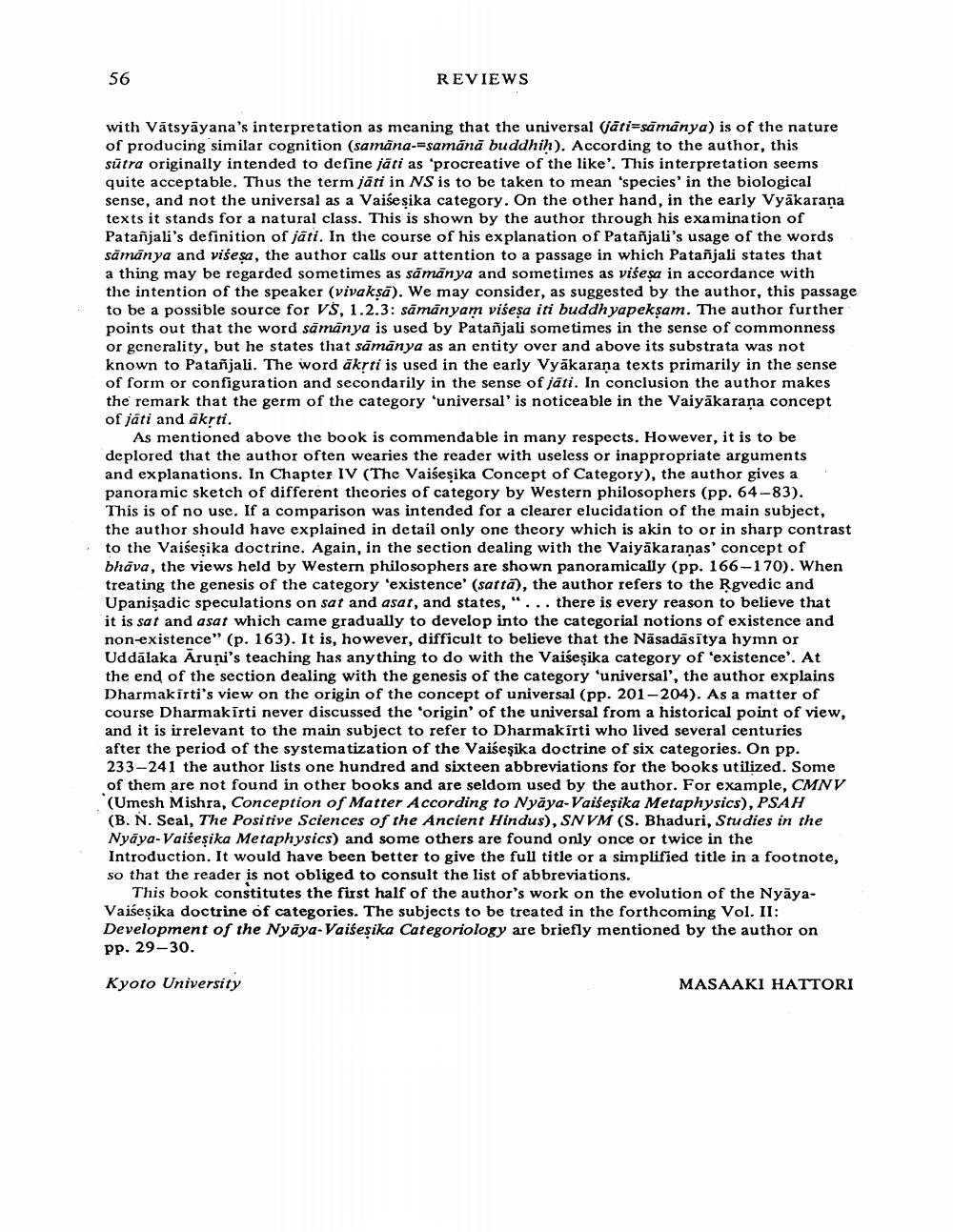Book Title: Reviews Of Diffeent Books Author(s): Masaaki Hattori Publisher: Masaaki Hattori View full book textPage 3
________________ 56 REVIEWS with Vatsyayana's interpretation as meaning that the universal (jati-samanya) is of the nature of producing similar cognition (samana-=samana buddhih). According to the author, this sutra originally intended to define jati as 'procreative of the like'. This interpretation seems quite acceptable. Thus the term jati in NS is to be taken to mean 'species' in the biological sense, and not the universal as a Vaisesika category. On the other hand, in the early Vyakarana texts it stands for a natural class. This is shown by the author through his examination of Patanjali's definition of jati. In the course of his explanation of Patanjali's usage of the words samanya and visesa, the author calls our attention to a passage in which Patanjali states that a thing may be regarded sometimes as samanya and sometimes as visesa in accordance with the intention of the speaker (vivaksa). We may consider, as suggested by the author, this passage to be a possible source for VS, 1.2.3: samanyam visesa iti buddhyapeksam. The author further points out that the word samanya is used by Patanjali sometimes in the sense of commonness or generality, but he states that samanya as an entity over and above its substrata was not known to Patanjali. The word akrti is used in the early Vyakarana texts primarily in the sense of form or configuration and secondarily in the sense of jati. In conclusion the author makes the remark that the germ of the category 'universal' is noticeable in the Vaiyakarana concept of jati and akrti. As mentioned above the book is commendable in many respects. However, it is to be deplored that the author often wearies the reader with useless or inappropriate arguments and explanations. In Chapter IV (The Vaisesika Concept of Category), the author gives a ? panoramic sketch of different theories of category by Western philosophers (pp. 64-83). This is of no use. If a comparison was intended for a clearer elucidation of the main subject, the author should have explained in detail only one theory which is akin to or in sharp contrast to the Vaisesika doctrine. Again, in the section dealing with the Vaiyakaranas' concept of bhava, the views held by Western philosophers are shown panoramically (pp. 166-170). When treating the genesis of the category 'existence' (satta), the author refers to the Rgvedic and Upanisadic speculations on sat and asat, and states, "... there is every reason to believe that it is sat and asat which came gradually to develop into the categorial notions of existence and nonexistence" (p. 163). It is, however, difficult to believe that the Nasadasitya hymn or Uddalaka Aruni's teaching has any thing to do with the Vaisesika category of 'existence'. At the end of the section dealing with the genesis of the category 'universal', the author explains Dharmakirti's view on the origin of the concept of universal (pp. 201-204). As a matter of course Dharmakirti never discussed the 'origin of the universal from a historical point of view, and it is irrelevant to the main subject to refer to Dharmakirti who lived several centuries after the period of the systematization of the Vaisesika doctrine of six categories. On pp. 233-241 the author lists one hundred and sixteen abbreviations for the books utilized. Some of them are not found in other books and are seldom used by the author. For example, CMNV (Umesh Mishra, Conception of Matter According to Nyaya-Vaisesika Metaphysics), PSAH (B. N. Seal, The Positive Sciences of the Ancient Hindus), SNVM (S. Bhaduri, Studies in the Nyaya-Vaisesika Metaphysics) and some others are found only once or twice in the Introduction. It would have been better to give the full title or a simplified title in a footnote, so that the reader is not obliged to consult the list of abbreviations. This book constitutes the first half of the author's work on the evolution of the NyayaVaisesika doctrine of categories. The subjects to be treated in the forthcoming Vol. II: Development of the Nyaya-Vaisesika Categoriology are briefly mentioned by the author on pp. 29-30. Kyoto University MASAAKI HATTORIPage Navigation
1 2 3
